Wide-format Printing: Producing fabric graphic displays
by all | 19 September 2014 1:11 pm
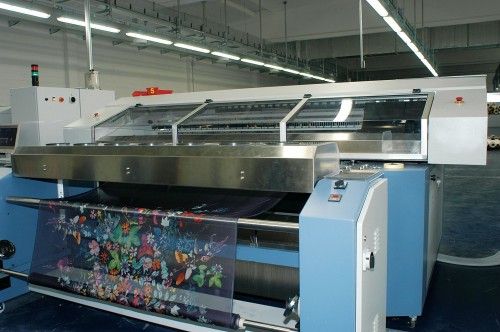 [1]By Ken Bach
[1]By Ken Bach
Fabric graphics are hotter than ever. Both the quality and the variety of digitally printed textile-based displays are on the rise today, due to the development of new printing technologies and display hardware. There are now several popular ways to print both common and uncommon applications on fabrics, all of which emphasize the differences from printing on vinyl.
Printing onto fabrics dates back hundreds of years, with the earliest applications involving processes like block, copperplate, roller and stencil printing. It wasn’t until the development of digital dye sublimation printers in the early 1990s that textiles and digital printing began to converge. And with the development of digital direct-to-textile printers around 2006, fabric-based signage became easy and viable for more shops to produce.
This trend has since seen significant growth. Textiles are now digitally printed for a variety of markets, including signage, apparel, furniture, theatre, trade shows, galleries, museums, retail, photo studios, schools, health care and special events.
A sign shop can print fabric-based banners, trade show backdrops, backlit displays and point-of-purchase (POP) graphics and even expand into other applications, like table covers, flags, tents, upholstery, floor mats, temporary/soundproof walls, sails and kites.
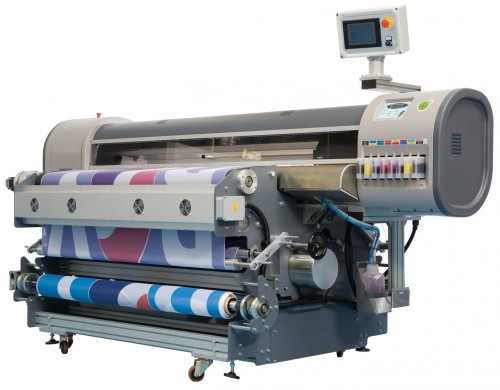 [2]
[2]With the development of digital direct-to-textile printers since 2006, soft signage has become easier for more shops to produce.
Dye sublimation has become widely used for banners and trade show graphics in recent years due to tighter environmental regulations. Compared to their vinyl counterparts, they are easier to ship, wash, reuse and recycle and contain none of the volatile organic compounds (VOCs) many cities have prohibited in certain circumstances. They are also proving more popular than vinyl for photography backdrops because of their non-glare finish.
By 2009, the global digital textile printing industry was worth about $200 million worldwide. By the end of 2014, it is expected to reach $1.6 billion, with some 52,800 digital textile printers installed around the world. Much of that growth has been driven by the signage and display markets.
Methods of attachment
While there are technically many methods for printing graphics on textiles, there are ultimately only two ways to attach ink to fabric. One is to glue the ink onto the fabric; this is the case with solvent-based, pigment-based, durable aqueous ‘latex’ and ultraviolet-curable (UV-curable) inks. Another is to bond the ink chemically into the fabric’s fibres; this is how dye sublimation, acid and reactive inks are processed.
Glue-based bond
For the first method, the inks need ‘binders’ to serve as the glue. In many cases, heat must be applied to activate the binder. The ‘feel’ of the fabric will change, depending on the strength of the binder. Latex inks tend to be among the best in this class, whereas UV inks may become ‘hidden’ in the fabric and not be cured properly, leaving an odour, and solvent-based inks do not tend to look as good.
Advantages of inks with glue-based bonds are lower upfront costs, versatility with many types of fabrics and compatibility with printers commonly found in sign shops. Among the disadvantages, the resulting images can be scratched or rubbed off to various degrees, colour brilliance may be poor due to ink settling around the fibres and ‘pass-through’ is not very good for demanding applications like flag production.
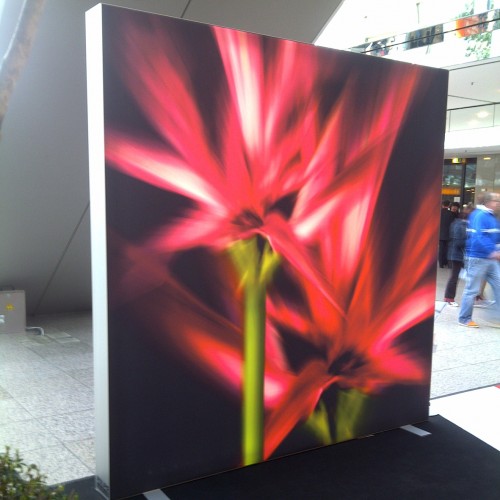 [3]
[3]Thanks in part to their non-glare matte finish, dye-sublimated fabric graphics are becoming popular for photographic backdrops. Photo courtesy Comhan Canada
Chemical bond
When dye-sublimation inks or dispersed dyes are printed onto polyester or polymer-coated media, they truly dye the fabrics, as the chemical reaction bonds them to the fibres. A final fixing process is also required, usually involving the application of heat, but the resulting images will never rub or scratch off and there is no change in the feel of the fabric. Pass-through is excellent, making this the preferred method for flag production. Colours are very vibrant and retain sharp details. Upfront costs, however, are high.
Advantages of dye sublimation
The highest-quality method for printing on textiles for signage applications is dye sublimation, which involves printing images either directly onto fabric or indirectly via transfer paper. Under high temperature and pressure, the dye is transformed into a gas to penetrate the fabric, where it solidifies into the fibres.
If done correctly, the dye is permanently bonded to the substrate, so the image is a part of the material and will resist scratching, rubbing off and deterioration.
Dye sublimation inks uses low-energy dispersed dyes, but the inks most commonly referred to as dispersed dyes are high-energy and, when used in direct dye sublimation printers, achieve less than optimal results. They do not sublimate in the same way as low-energy dyes and tend to leave excess ink on the finished print. Truly dispersed dye systems require a wash-and-dry sequence after heating.
As suggested, there are two methods for dye sublimation: direct and transfer.
The first is a one-step process using a digital printer with a built-in heater. This method is sensible for flags and other applications calling for saturation of the fabric to achieve bold colours on two sides.
The second method is a two-step process that first uses a digital printer to produce an image in reverse on coated transfer paper. Then, heat is used to transfer the image from the paper onto the fabric substrate. Compared to direct printing, this results in truer, photorealistic image fidelity and higher resolution.
With the second method, the heat is provided with an external press. The heat must be distributed evenly from left to right. Oil drums tend to be the most efficient tools for this purpose and their size will directly affect production speed. Belt tension control is also important for ensuring image quality and a vacuum will increase ink penetration.
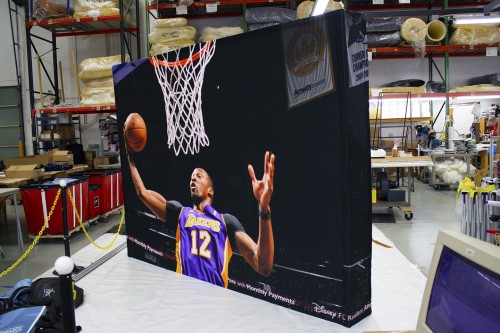 [4]
[4]New frames and other display hardware have also fuelled the growing popularity of fabric graphics. Photo courtesy Global Imaging
Making the best decision
If a sign shop needs one printer to produce graphics on both vinyl and fabrics, then a latex inkjet system would be the best option, due to its versatility. For a fabric-only printing system, on the other hand, dye sublimation remains the best bet.
For a low-volume production environment where ease of operation is important, a direct dye sublimation system is a good fit. For maximum flexibility in terms of fabric types and for high-volume production, transfer-based dye sublimation is preferable.
Not every shop is ready, of course, to focus on fabric graphics. Those equipped with a solvent-based inkjet printer could enter the market by starting to offer a limited range of lower-end applications. And in some cases where a signmaker would like to offer fabric graphics, but needs to build up the business first, outsourcing specialized production is a viable alternative.
Not all fabrics are equal
Fabrics are produced with all types of textures and other attributes. The choice of fabric will depend on the application.
There are stretchy and non-stretchy options, for example, as well as fire-retardant coatings that are required by some building codes for indoor graphics. As mentioned before, a fabric with high pass-through quality is needed for flags. Strength, durability and shrinkage also vary by material.
Further, fabrics produced with non-dye-sublimation printing in mind are finished with different coatings for use with different popular ink sets (e.g. solvent or latex), as ink-to-fabric compatibility is a significant factor in an application’s success. It is a question of how well the coating holds the ink drops.
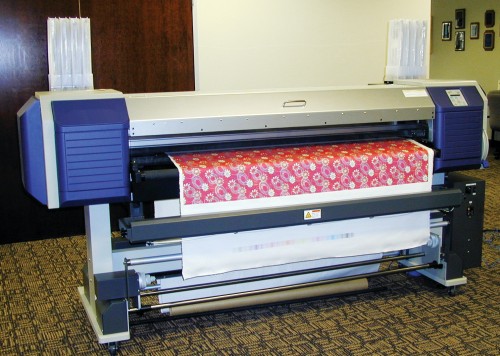 [5]
[5]Wide-format textile printers that can handle a greater variety of fabrics— including stretch fabrics—have strong potential for the sign industry.
Finishing and displaying
The most common type of finishing for fabric graphics and flags is sewing, but other options include hot-knife cutting, glue, rivets and tape. Grommets can be added to the fabric to create hanging signs.
Silicone-edge graphics are proving very popular due to their versatility in terms of sizes and shapes. Unlike fabric graphics finished with bead or pole pockets, the sew line is hidden within the extrusion, providing a cleaner look for frontlit and backlit exhibits and POP wall displays. With the silicone edge offering a less visible frame, people see more graphic and less hardware.
Other common display hardware options include retractable banner stands, lightweight pop-up ‘pillow case’ structures and tear drop frames, all of which can be set up without needing special tools.
The value of fabrics
Fabric graphics represent a growing market. If a sign shop does not serve this market, then its competitors will.
Fortunately, fabric printing can be as easy as vinyl printing—and the profit margins are much higher, due to the perception of fabrics’ richer, higher value. The customer saves money anyway, though, through lower costs for shipping, storing and installation.
Ken Bach is business development director for Aberdeen Fabrics, a mill that produces fabrics specifically for the sign and graphics industry. He will be discussing dye sublimation and fabric graphics at ImagiNation 2014, a Roland DGA inkjet user conference on October 21 in Las Vegas, Nev. For more information, contact him via e-mail at kbach@aberdeenfabrics.com[6] and visit www.rolanddga.com/imagination[7].
- [Image]: http://www.signmedia.ca/wp-content/uploads/2014/09/textiles_monnalisa.jpg
- [Image]: http://www.signmedia.ca/wp-content/uploads/2014/09/textiles_ViperTX-copy.jpg
- [Image]: http://www.signmedia.ca/wp-content/uploads/2014/09/bewerkt-tflex11.jpg
- [Image]: http://www.signmedia.ca/wp-content/uploads/2014/09/Lakers-Standing-Graphic.jpg
- [Image]: http://www.signmedia.ca/wp-content/uploads/2014/09/textiles_YK_MC3.jpg
- kbach@aberdeenfabrics.com: mailto:%20kbach@aberdeenfabrics.com
- www.rolanddga.com/imagination: http://www.rolanddga.com/imagination
Source URL: https://www.signmedia.ca/wide-format-printing-producing-fabric-graphic-displays/